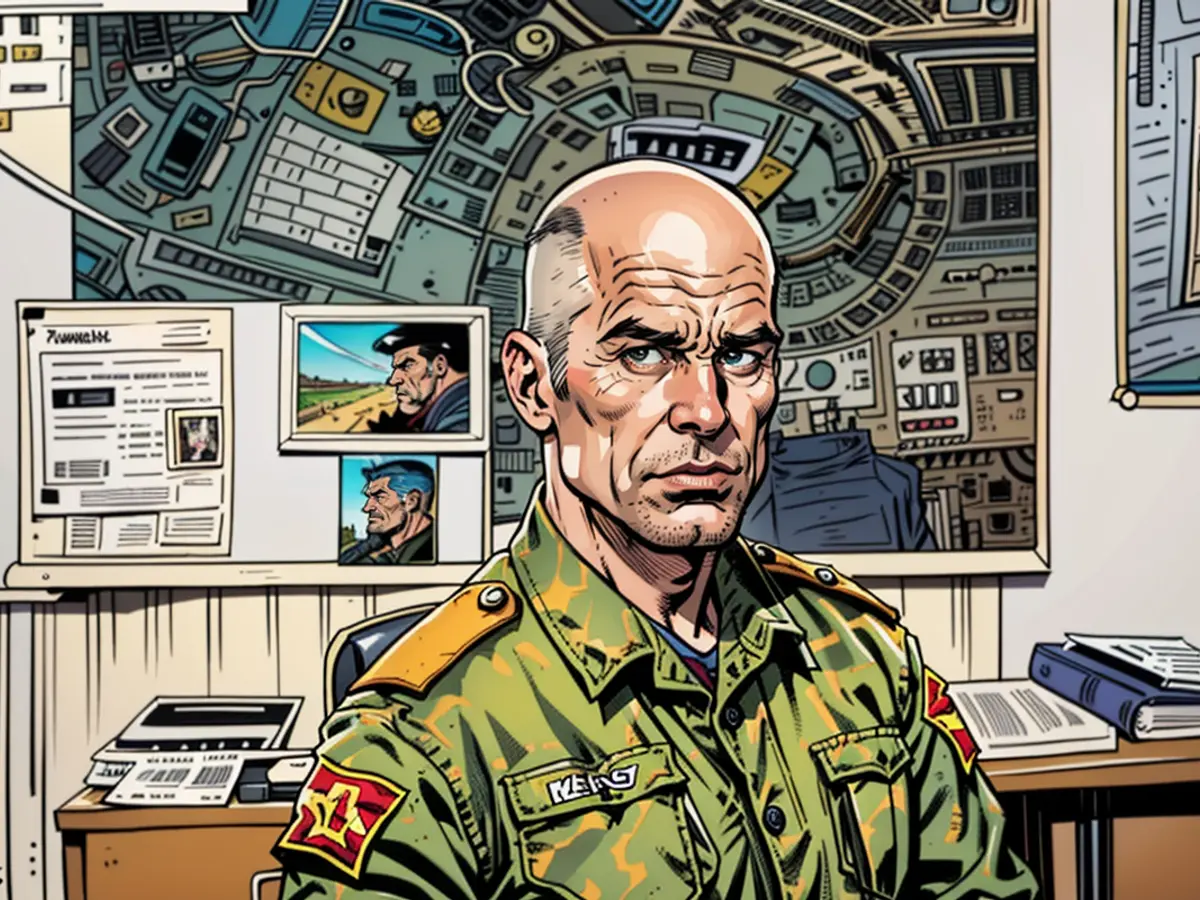Ukraine suggests disintegration of the Donbass frontline
From the few F-16 fighter jets that have arrived in Ukraine, one has already encountered an incident. How severe is this situation, and how long can Kyiv's troops defend Pokrovsk against the Russians? What factors will determine the intense battles, as Colonel Markus Reisner explains to ntv.de.
ntv.de: Colonel Reisner, last week you mentioned the possibility of a western-supplied F-16 fighter jet being targeted and the severe consequences that it could entail. It now seems to have occurred. What information is available on this matter?
Markus Reisner: At present, there are differing accounts of the situation. Initial reports suggested a crash, followed by speculation of a tragic friendly fire incident by a Ukrainian Patriot air defense system. However, US officials deny these claims. It's plausible that the F-16 and its pilot were struck either by a Russian cruise missile during the relentless air assault on August 26 or due to a mechanical issue or maintenance error. All of this remains unconfirmed at this time.
What can be derived from this incident? Is it, perhaps, too bold to put pilots in harm's way immediately following limited exposure to the new system's operation?
If we're to assume a misguided Patriot air defense battery strike, it implies that Ukraine is undergoing challenges in creating an accurate, updated air situational awareness picture. This is referred to as an "Recognized Air Picture" (RAP), a digitally networked map that monitors all air movements, including friendlies and adversaries, aiding in targeted assignments.
In what manner would such an incomplete RAP affect the situation?
Major blunders can ensue, including the unfortunate downing of friendly aircraft. If the pilot is responsible for the possible mishap, it could indeed be an error in handling. If the Russians are responsible, it highlights their continuous surveillance of Ukrainian airbases.
Thus far, the Kremlin is seemingly making little use of the destroyed F-16 for propagandistic purposes. Could you explain this pattern?
Russian social media platforms have attempted to smear the Ukrainian air force command, attempting to paint the F-16 deployment as an early stumbling block and subsequently attributing the aircraft's loss to a Russian triumph. However, they lack concrete evidence to support their claims. No compelling videos of an air raid engagement or a visible hit on a grounded F-16 have surfaced, thereby casting doubt on the Russians' responsibility for the loss.
Over the past few days, there has been heightened interest in Pokrovsk in eastern Ukraine. It is reported that many are fleeing the area due to the supposed Russian advance towards the city. What is the current status there?
The Russians continue their advance against Pokrovsk, applying significant pressure to the city. From Kupyansk to Saporizhzhia, they are engaging six operational maneuver groups, with two more forces amassing near Kharkiv and Kursk. In the Donbass, three of these maneuver groups create a formidable coalition, totaling approximately 150,000 troops, aiming to breach Ukrainian defensive lines. The Ukrainian assault at Kursk was intended to thwart the height of the Russian summer offensive and deflate their momentum. However, their efforts were unsuccessful. Severe combat is now erupting in and around Pokrovsk, a vital Ukrainian logistics hub and bastion for the third defense line.
On the Ukrainian side, the news of intense fighting at Pokrovsk is being disseminated. What does this imply?
This refers to the prolonged, debilitating skirmishes taking place in and around Pokrovsk, resulting in substantial losses and marginally progressive gains for both sides.
The Russians are steadily capturing settlements to the east of Pokrovsk, demonstrating incredible speed and causing relatively minimal damage to the captured sites. Russian forces have penetrated the second defensive line, with a ripple effect in play: the fall of one settlement places the neighboring Ukrainian defenders' flank under duress, leading them to retreat and facilitating the subsequent fall of additional settlements to the Russians. Socials media images reveal the brutality of the close-quarter combat, resulting in heavy casualties on both sides.
If Pokrovsk were to be captured, could the Ukrainians potentially create a barrier by disrupting this "corridor" from the north and south, thereby isolating the enemy troops from their supply lines and even encircling them?
They would need mobile, uncommitted reserves - ready-for-action troops in close proximity and in a combative state.
How does one define "combat-ready" in this context?
"Combat-ready" denotes that they must be mechanized, incorporating tanks, to amass the necessary striking power. The mobilization of strategic reserves is also a possibility, but these troops would first need to be deployed. Ukraine has expressed intentions to resurrect brigades 160 to 169 this year. Earlier this year, they attempted to revitalize brigades 150 to 159, initially earmarked for an upcoming offensive but quickly thrust into the most critical frontline sections.
When the Russian troops are still some distance from Pokrovsk, could we expect a shift towards urban combat if they manage to penetrate developed areas?
We have bearing witness to comparable situations in the previous two-and-a-half years, including the battles of Mariupol, Lysychansk, Bakhmut, and Avdiivka. In these instances, defenders possess an advantage due to their ability to conceal themselves and establish ideal vantage points within urban environments, employing hit-and-run tactics. In turn, Russia responds with overwhelming force, obliterating entire city blocks with artillery, rocket launchers, and guided munitions. And now, Pokrovsk faces an identical fate.
Upon capturing the city, what areas would witness the greatest challenges for the Ukrainians if the Russians were to control Pokrovsk?
Is Ukraine capable of safeguarding the city against the Russian assaults?
The capability of Ukraine to defend hinges on the strength of both sides' forces. Despite their withdrawal, Ukraine's position is bolstered by the weary state of the Russian troops. No further formidable and combat-ready reserves are readily available to support the Russian attackers at the crucial juncture. Nevertheless, both parties are exhausting their resources in this battle. The one with the lasting stamina and resources will emerge victorious.
In the context of Kursk, where Ukraine has held Russian territory for extended periods, do the Russian troops stationed there possess sufficient strength to thwart the Ukrainian advance?
This is a complicated scenario influenced by factors such as resource availability, troop morale, and each side's strategic objectives. While Russia has sent reinforcements to the region, the Ukrainian military has shown remarkable resilience and adaptability in the face of the Russian offensive. The fate of Kursk will likely be decided by both sides' ability to maintain their offensive drive and secure vital resources.
The Ukrainian offensive in Kursk has encountered a slowdown. We are witnessing an escalation in Russian counterattacks. Meanwhile, the Ukrainians are striving to establish robust defensive positions by surrendering extensive open areas and capturing forests, heights, or settlements. This strategy is beneficial for a defensive battle as these locations offer cover. However, the Russian air superiority and electronic warfare measures are posing growing challenges for the Ukrainians. They are consistently attempting to remain agile and swift in Kursk.
Can Ukraine successfully fortify their territorial gains and perpetually retain these forests, heights, and settlements in the face of Russian resistance?
Just like in Donbass, the outcome depends on the condition of the troops on either side. The Russians are receiving reinforcements each day, particularly from the area north of Kharkiv, where Russian attacks are nearing a standstill. The Russians are methodically advancing in Kursk and Kharkiv, methodically clearing areas and targeting strategic objectives with artillery and guided bombs. Their goal is to exhaust the Ukrainians. Ukraine must break free from this vicious cycle, but it faces a significant disadvantage: Western allies, primarily the United States, restrict the deployment of advanced Western weaponry beyond Russian lines.
Frauke Niemeyer had a conversation with Markus Reisner
- Given the incident involving the F-16 fighter jet in Ukraine, how might this affect the country's ability to defend their airspace and key locations like Pokrovsk, considering the potential challenges in creating an accurate "Recognized Air Picture" (RAP)?
- Amidst the ongoing conflict in Pokrovsk, what role could Ukraine's limited combat-ready reserves play in potentially disrupting Russian supply lines and potentially encircling enemy troops, if the city were to be captured by the Russians?









